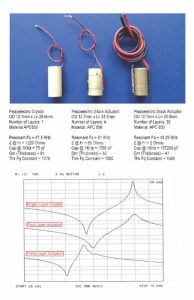By: Jeff Zahnd, VP Engineering, APC International, Ltd
APC has been supplying Stack Actuators for many years for a variety of applications. Typically, these are used in fine positioning or small movement applications at very low frequencies. Examples include positioning for ultrasonic wire bonding, tuning of laser and optical systems, fine positioning of microscopes, and many others. We have also seen stack actuators used in a variety of demanding applications when the science and physics support their use. Examples include stack actuators in auto fuel injection systems, various types of piezoelectric motors, vibration and shaker sources, and other high movement, high force applications.
Another area of use that is often overlooked is using stack actuators in acoustic or ultrasonic systems as ultrasonic transducers. The main reasons for considering stack actuators as ultrasonic transducers are to achieve lower ultrasonic frequencies and/or higher capacitances in restricted package sizes. The use of stack actuators as ultrasonic transducers is often cost prohibitive, but they are an option that occasionally makes sense. The construction of a stack actuator has the benefit of lowering the thickness frequency constant and increasing the capacitance by orders of magnitude when using multiple layers of piezo elements connected electrically in parallel. The higher capacitance will lower the device impedance at it’s resonant frequency. This lower impedance means a lower drive voltage can be utilized. The length of the actuator must be greater than it’s diameter to ensure the radial frequency is always higher than the thickness frequency.
Figure 1 illustrates several examples and the effect of multiple layers on device impedance:

Figure 1: 1 layer, 4 layer, and 30 layer actuator and the respective resonance performance of each
As you can see from the examples listed in figure 1, it is possible to have a significant change in thickness resonant frequency, impedance at resonant frequency, and capacitance by stacking layers to build an actuator. The stack actuator is constructed of multiple layers of piezo elements that are bonded mechanically in series but electrically in parallel. This configuration works well for fine positioning at low frequencies (Less than 100 Hz), but there are limits when trying to use stack actuators as ultrasonic transducers at high frequency. Higher drive levels can cause internal stresses which may cause damage to the actuator, so these devices (when considered for transduction) are best suited for applications with low to moderate power requirements. An example of this would be using a stack actuator as a transmitter and/or receiver in pulse echo applications. Higher drive levels are sometimes possible for pulsed or tone burst excitation, if the repetition rate is low. Average power must remain in the low to moderate range to prevent damage to the actuator.
The uses of stack actuators as ultrasonic transducers are limited, but there are several applications where they should be considered. Contact APC to discuss your specific application!